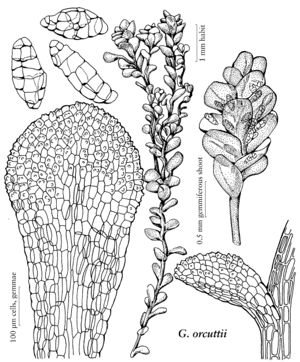Gymnostomiella
Musc. Buitenzorg 1: 309. 1904,.
| Taxon | Illustrator ⠉ | |
|---|---|---|
 | Gymnostomiella orcuttii | Patricia M. Eckel |
Plants growing in dense tufts or mats, light green to blackish green distally, brown proximally. Stems 1.5–6 mm; hyalodermis absent, sclerodermis absent or weak, central strand present, large; axillary hairs ca. 3 cells in length, moniliform, proximal cell thicker walled. Stem-leaves erect or laxly spreading when dry, erect to spreading and lax when moist; obovate to oblong-obovate, adaxial surface broadly channeled to nearly flat, larger distally, 0.3–0.4 mm; base not differentiated in shape, proximal margins not differentiated; distal margins plane, crenulate distally by sharply bulging cell-walls, sometimes serrulate, often with 1–2 teeth above; apex rounded or very broadly acute, occasionally apiculate; costa slender and ending at mid leaf or stronger and ending near apex, adaxial outgrowths absent, adaxial cells elongate, in 2 rows; transverse-section elliptic, adaxial epidermis absent, adaxial stereid band absent, guide cells 2 in 1 layer, hydroid strand absent, abaxial stereid band small, round in sectional shape, abaxial epidermis present; proximal cells weakly differentiated across lamina, rectangular, little wider than distal cells, 2–3: 1, walls of proximal cells thin; distal medial cells quadrate to hexagonal, sometimes longer than broad, 12–18 µm wide, 1 (–2):1, 1-stratose; papillae small, simple, hollow, conical, 1–3 per lumen, scattered, cell-walls thin, delicate, convex on both sides. Specialized asexual reproduction by elliptic to clavate gemmae, to 280 µm, of about 12 cells, borne in leaf-axils or on adaxial surface of the leaf. Sexual condition dioicous. Perigonia terminal. Perichaetia terminal, interior leaves sheathing, ovate, to 0.7 mm, laminal cells laxly rectangular, smooth. [Seta 3–6 mm. Capsule stegocarpous, theca ovate to elliptic, 0.6–0.8 mm, annulus of about 2 rows of little differentiated cells; operculum obliquely rostrate from a low-conic base; peristome teeth absent. Calyptra cucullate. Spores 11–15 µm.] KOH laminal color reaction yellow or negative to black or pink to deep purple.
Distribution
Fla., pantropical
Discussion
Species 6 (1 in the flora).
In the absence of a peristome and no special trait characteristic of another family, Gymnostomiella is referred to the Pottiaceae largely because of its papillose leaves. Phylogenetic analysis supports a hypothesis of a relationship with Barbula and relatives. Distinctive are the central location of the stereid band, the moniliform axillary hairs, the often nearly spheric capsule, and the KOH color reaction of the lamina being variously negative, pink, yellow, black or purple. Cyanobacteria that are often associated with this genus are thought (T. Seki and C. Miyagi 1980) to be important in nitrogen fixation as “parasymbiosis.” J. L. de Sloover (1977) provided a key to all species of the genus.